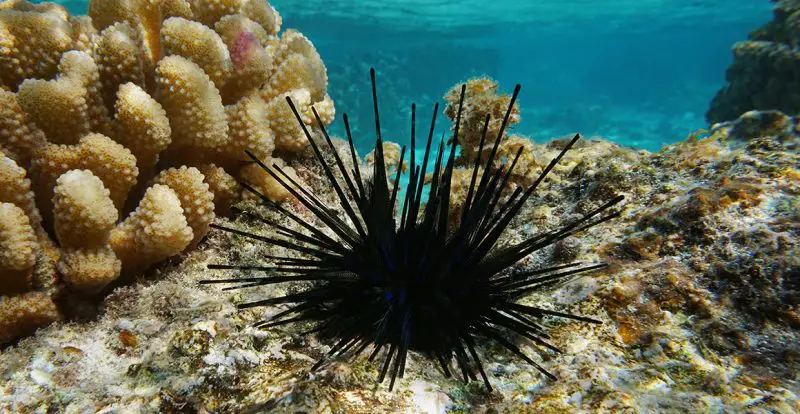At first glance, it might seem strange to link a tiny ocean-dwelling creature to a land-based mammal like the hedgehog. Yet, both in English and several other languages, sea urchins are commonly referred to with names that draw a direct comparison to hedgehogs. But why? What do these two vastly different creatures have in common, and how did sea urchins get their name?
This article explores the fascinating story behind the name “sea urchin,” diving into the historical, linguistic, and biological roots that link these two spiny species.

The Etymology of “Sea Urchin”
From Old English to Ocean Depths
The word “urchin“ may sound quirky today, but its roots run deep through the linguistic layers of medieval Europe. It evolved from the Middle English word irchin, which was derived from the Old French herichon—a term that quite literally meant “hedgehog.” Long before it had any marine association, “urchin” was simply a way to refer to the spiny, insect-eating mammal known for curling into a ball when threatened.
By the 14th century, English speakers had begun to apply the word more broadly. Anything small, round, and bristling with sharp points could earn the name “urchin.” When European naturalists began exploring tidepools and seafloors and encountered strange, globular creatures covered in stiff spines, the resemblance to hedgehogs was striking. These marine invertebrates didn’t resemble fish, and they certainly weren’t mollusks—yet their spiky exteriors looked undeniably like the woodland creature.
Thus was born the term “sea urchin”—a poetic, visual metaphor meaning “hedgehog of the sea.” The name has stuck for centuries, crossing not only scientific descriptions but also common vernacular, thanks to the enduring imagery of a prickly sphere moving slowly across the ocean floor.
Shared Features Between Sea Urchins and Hedgehogs
A Striking Spiny Appearance
If there’s one feature that instantly links sea urchins and hedgehogs, it’s their spines—those sharp, bristling projections that give both animals their unmistakable look. These spines aren’t just for show. For both species, they serve as the first and most vital line of defense. When danger approaches, the message is clear: come closer at your own risk.
Sea urchins boast hundreds of stiff, movable spines that radiate in all directions, transforming them into slow-rolling sea mines. These spines can even be venomous in some species, deterring would-be predators from taking a bite. Similarly, hedgehogs rely on their needle-like quills, stiffened hairs that they can raise defensively. When curled into a ball, a hedgehog becomes a near-impenetrable sphere of spikes.
Though their environments are worlds apart—one rocky tidepool, the other forest underbrush—the visual and functional parallels are undeniable. Their spiny silhouettes serve as universal warning signs in nature’s visual language.
Compact, Rounded Bodies
Beyond the spines lies another shared trait: their shape. Both animals have evolved to be compact, rounded, and self-contained, with their limbs and soft parts tucked away from danger. For sea urchins, this comes in the form of a rigid, globe-like shell called a test, which houses all their internal organs and provides attachment points for their spines and tube feet.
Hedgehogs, meanwhile, rely on flexibility and muscle control to curl into a tight, protective ball—shielding their soft underbellies and presenting only a spiny exterior. This shape not only enhances their defense but also contributes to the striking resemblance between the two species, one on land and one at sea.
What these animals share isn’t ancestry—it’s a shared evolutionary solution: protect the vulnerable core by wrapping it in armor, whether keratin or calcium carbonate.
A Name That Stuck Across Cultures
The connection between sea urchins and hedgehogs isn’t just an English phenomenon—it’s a global one. Across many cultures and languages, the spiky, spherical appearance of sea urchins has inspired names that evoke the hedgehog or similarly prickly animals.
- French: oursin, which is related to ourson (“little bear” or sometimes used endearingly like “hedgehog”)
- Spanish: erizo de mar, literally translated as “sea hedgehog”
- Italian: riccio di mare, also meaning “sea hedgehog”
- German: Seeigel, combining “See” (sea) and “Igel” (hedgehog)
What’s remarkable is the consistency of imagery: no matter the language, the sea urchin’s spiny armor and round body clearly remind people everywhere of the hedgehog. It speaks to a universal way that humans interpret form and function in nature—through metaphor and resemblance. The sea urchin’s name has endured because it so perfectly captures what our eyes instinctively recognize: a tiny, armored creature whose appearance warns us not to get too close.
Are Sea Urchins and Hedgehogs Related?
Despite the name and surface-level similarity, sea urchins and hedgehogs belong to entirely separate branches of the animal kingdom. Hedgehogs are warm-blooded mammals in the class Mammalia, characterized by fur, live births, and complex nervous systems. In contrast, sea urchins are cold-blooded, marine invertebrates in the phylum Echinodermata, which also includes starfish and sand dollars.
This means the two are not closely related—not even remotely. Their common spiny appearance is a classic example of convergent evolution, where unrelated organisms independently develop similar features as adaptations to similar challenges. In this case, the challenge was defense. Both hedgehogs and sea urchins evolved sharp, protective coverings to keep predators at bay.
So while they may resemble each other at a glance, hedgehogs and sea urchins are products of different worlds—land and sea, mammal and invertebrate—linked only by nature’s repeating patterns.
Conclusion
Sea urchins may seem like alien creatures of the deep, but their name connects them to something far more familiar. By calling them the “hedgehogs of the sea,” early observers highlighted the key visual traits that made these animals stand out: a compact, spiny body built for survival.
Though they share no evolutionary ties, sea urchins and hedgehogs will forever be linked by the creative lens through which humans interpret the natural world. And thanks to that lens, the name “sea urchin” continues to evoke curiosity, charm, and just a hint of prickly danger.






